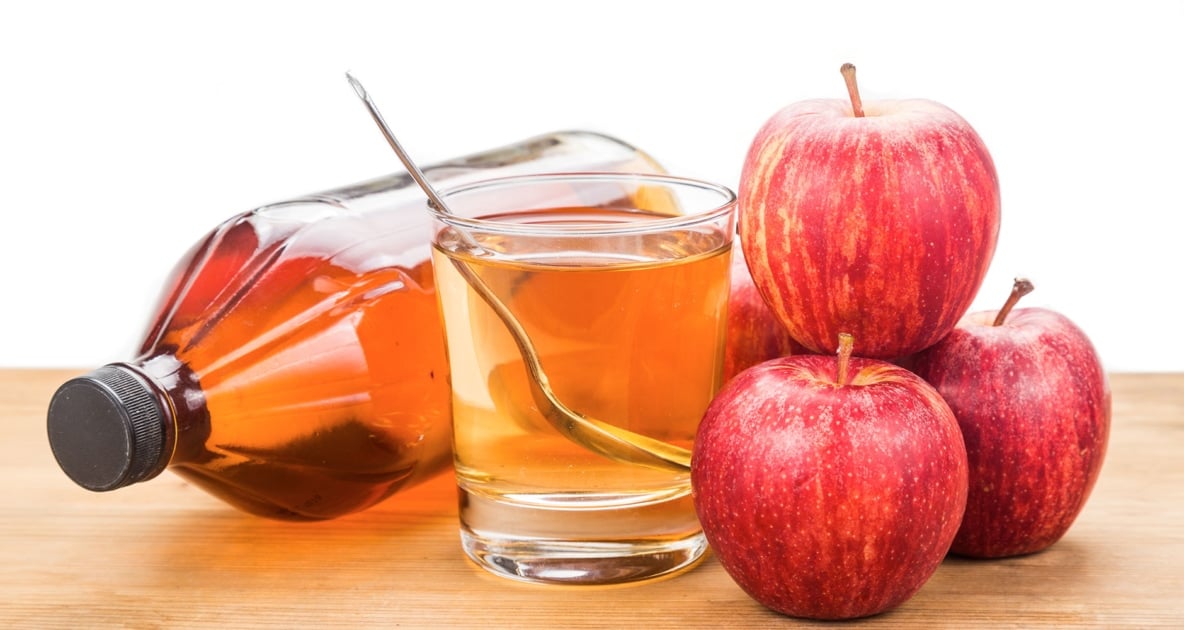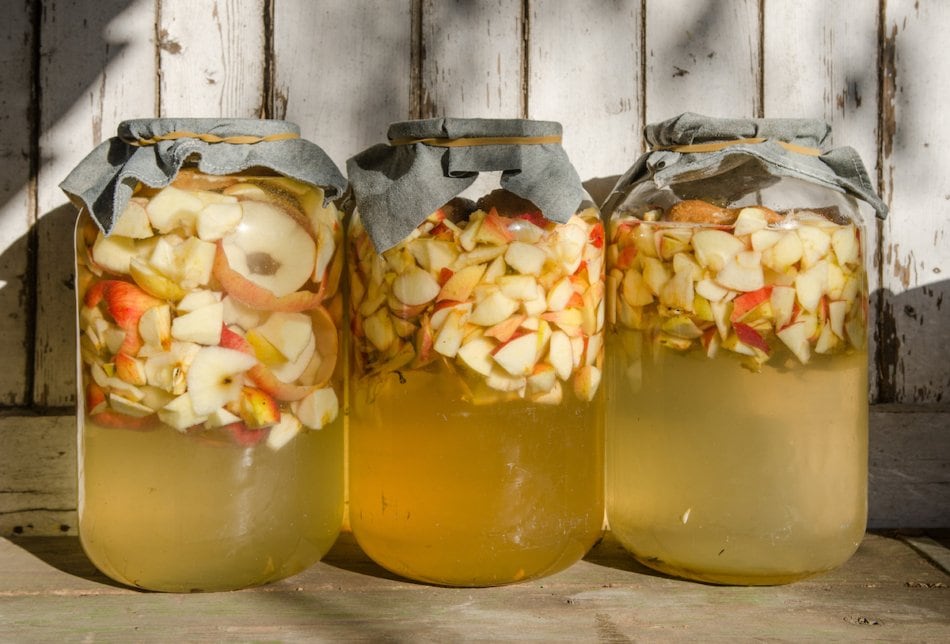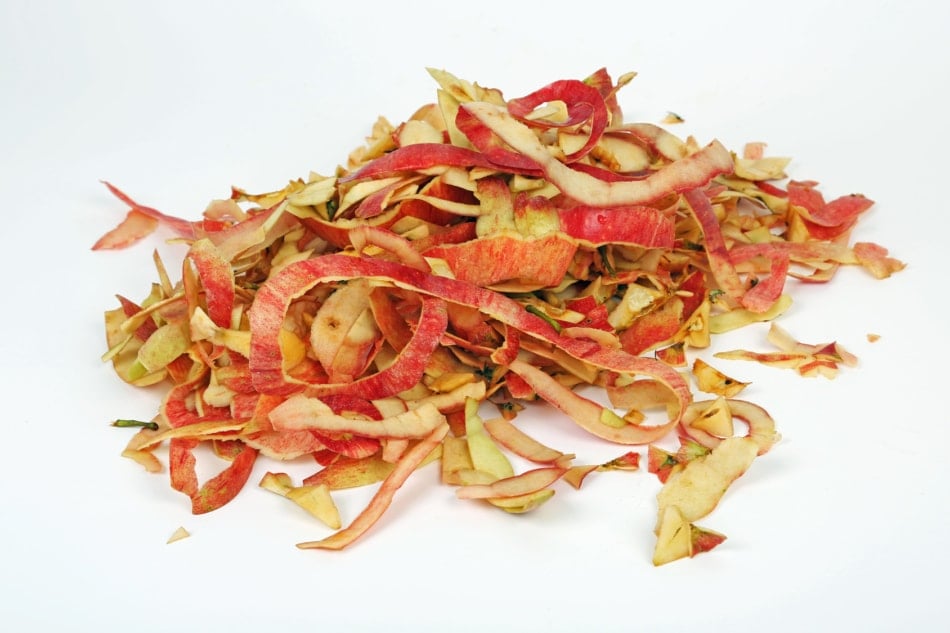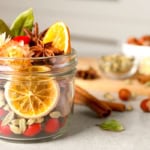Make Your Own Apple Vinegar!
This easy DIY method uses your leftover fall apple cores and peelings to make an authentic batch of nature's best natural remedy.

Fall is the time of year for lots of apple eating and pie baking, so why not put those scraps to use and make your own raw apple vinegar? It’s easy to do, with all the peels and cores you’ll have leftover from fresh apples.
The benefits of apple cider vinegar are endless. True apple cider vinegar is a little different. you first make apple cider, and then ferment that apple cider into vinegar. This apple vinegar is good in salad dressings and other recipes that need an extra zing, but it’s a great natural remedy as well (the Farmers‘ Almanac has published countless articles on its use over the years, see below) — every household should have a bottle on hand. Making it yourself is easy and fun, and ensures you have the purest, freshest batch.
Apple vinegar can be made in large batches in a crock or a jug when peeling and coring large quantities of apples. But, for your first attempt, it’s wise to make a quart jar.
Apple Vinegar Making Tips

- Use organic apples free of pesticides.
- Select fruit free of mold, fungi or rot.
- Rinse fresh apples under running water.
- If you’re using whole apples, soak them in a bowl of water along with a tablespoon of apple cider vinegar for five minutes before peeling. The apple cider vinegar serves as a fruit wash to kill bacteria and remove any fungicide or pesticide residue.

Supplies and Ingredients:
- Quart canning jar
- Canning lid and ring
- Muslin cloth, or you can use a clean, unused coffee filter.
- Apple cores and peels
- Spring water
- Sugar (optional)
Instructions:
- Fill a sterilized quart jar with clean apple peels and cores. Or add apple scraps over the course of several days from your snacking apples (be sure to cut away bitten areas). Add spring or filtered water, free of chlorine, to the jar, ensuring that the apple scraps are completely covered.
- (Optional step) To speed up the fermentation process add ¼ cup of sugar to the jar and stir.
- Cover the filled jar with a circle of muslin cloth or the coffee filter and secure it with a rubber band or canning jar ring. This will help keep fruit flies out of the jar and permit the mixture to breathe.
- Place the jar out of direct sunlight, in a warm place, near a hot water heater, refrigerator, wood stove, or on top of the gas range, (but not directly on a burner), to speed up the fermentation process.
- After a few days, the contents of the jar should start to thicken. The mixture will begin to foam and bubble.
- After two weeks, strain out the apple scraps and pour the liquid into a clean quart jar. Cover as you did before with a muslin cloth and canning jar ring. Store on a pantry shelf.
- After a few weeks, the mixture should appear cloudy and a film will form on the surface. This is the “mother,” which can be used to start future batches of apple vinegar.
- At six weeks from the start, the fermentation process should be complete. There will be a residue inside the bottom of the jar and the vinegar will taste tangy. If the vinegar smell or taste is undeveloped, allow it to sit longer. Once the vinegar has developed, cap the jar with a lid and store in your pantry until needed.
- When you’re ready to make another jar of vinegar, remove the “mother” and add it to a new batch of apple scraps and water and repeat the process.
Note: This Apple Vinegar is slightly different than an Apple Cider Vinegar, since it’s difficult to know the exact strength of homemade apple vinegar, it’s best not to use it in canning or pickling recipes where a high concentration of acid is required.
Now you have a homemade batch of nature’s best natural remedy! Want more ideas for ways to use apple vinegar and apple cider vinegar? Check out these Farmers’ Almanac articles:
Apple Cider Vinegar Uses and Recipes
Natural Cures With Apple Cider Vinegar

Deborah Tukua
Deborah Tukua is a natural living, healthy lifestyle writer and author of 7 non-fiction books, including Pearls of Garden Wisdom: Time-Saving Tips and Techniques from a Country Home, Pearls of Country Wisdom: Hints from a Small Town on Keeping Garden and Home, and Naturally Sweet Blender Treats. Tukua has been a writer for the Farmers' Almanac since 2004.






I am making my first batch of apple cider vinegar. I followed all of your guidelines. When I went to get it out of the pantry to stir it this evening it had bubbled over. Is this normal?
Hello! My ACV has reached a total of 6 weeks old. I dont see a mother formed on top, just sediment at the bottom of the jar. The vinegar is cloudy and sort of has a nutty after taste. There is no mould, it smells great. I am concerned with the nutty after taste, is this normal?
I’m curious if I have made a mistake. At the surface of my jars, I have mold forming. They are organic apple scraps, I froze them fresh and began the steps by just adding the frozen apples to my jars. Not sure if I should toss the whole thing because of the surface mold. I did just try to remove the molded pieces and am monitoring.
It depends on the color of the mold. If it was a white, yeast looking mold, you can scoop out and continue on if you wish. If you do see fuzzy, blue, black or pink mold on the surface of your apple scrap vinegar, discard and start over with fresh ingredients and clean equipment. You also should be sure not to use chlorinated water, as it could kill the microbes that are needed to ferment the apples. You can leave tap water sitting out for a few days to allow the chlorine to evaporate.
May I use distilled water, purified water or maybe a regular bottle of water such as aqua fina/pure life etc.?
Thank you.
I made ACV almost 8weeks already but still its not tasted vinegar why pls reply thanks
If there a way that I can just use my tap water? I don’t know if it’s chlorinated or not. Perhaps I can boil it first?
Brief and explicit enough, thanks
Glad you enjoyed it, Ruthie.
My “mother” keeps turning black. It resembles mold. Is there a way to avoid this? Thanks
I know everyone is saying use scraps but can I just use the whole apple or cored apple? The seeds have arsenic in them, is it better if I take them out before I start the process or strain them out at the end? Will the arsenic get into my vinegar during the process?
Thank you
Laura, we haven’t had this problem. But you can use whole apples if you don’t want seeds in it.
Hi Kris, any container, as long as it’s glass.
Laura: yes you can use the whole apple. The seeds aren’t a problem.
As my cut apples covered in water for the past 3 weeks, the mixture is very cloudy and smells very sour! Have I ruined it????!I’m not sure if I have done something wrong. I did add some frozen scraps to the cut fresh organic apples to make my batch of ACV.
Your answer would be greatly appreciated!